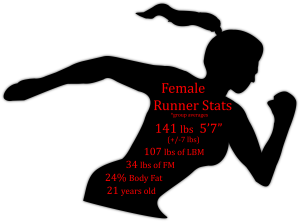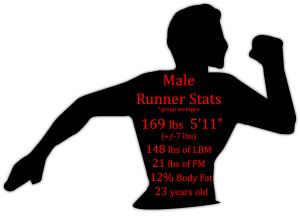What burns more calories, walking or running 1600 meters?
The study I’ll review today addresses many questions that I have had about walking and running. How many calories (kcals) does walking vs running a mile burn? How many kcals do males vs females burn? Does it matter if we walk/run the mile on a treadmill vs the track? What about the equations that estimate how many kcals we burn?! Are they accurate at all??
Well, this study puts some empirical examination on these questions and gives us some answers.
This post is made possible by the Hall, et al. team. The 2004 paper is titled, Energy expenditure of walking and running: Comparison with prediction equations.
Methods
There were 12 male and 12 female participants. Below are their descriptive stats. As always, they’re group averages and rounded to the nearest whole number for the ease of viewing.
All of the participants were “recreationally active”, as in they could complete the runs at the required pace. Each participant had their resting energy expenditure measured. Metabolic rate was measured while they sat quietly before they performed each exercise. That allowed the researchers to subtract the baseline energy expenditure and to show the expenditure due to the exercise itself. Each test was done on different days.
I’ve had my energy expenditure measured, both at rest and while active up to my VO2 max (on both a treadmill and a stationary bike). The gist is that you wear a mask that covers your mouth and nose. The mask is connected to a device that measures the oxygen you breath in and the carbon dioxide you exhale. That info is used to calculate your energy expenditure, aka how many kcals you burn. The device that the mask connects to can be placed on a cart to allow researchers to move with the participants throughout a study session. This mobility is how the researchers were able to measure the participants while they ran on a track.
The participants had their energy expenditure measured while they walked 1600 meters (a standard competitive track and field distance, which is 9 meters short of a mile) at a pace of 3mph and separately while they ran for the same distance at a pace of 6mph. The participants did this both on a track and on a treadmill at the university.
Results
The kcal burn results are listed below. They’re listed by sex and, as always, they’re group averages and rounded to the nearest whole number for the ease of viewing.
As you can see, running the 1600 meters burned twice as many kcals as walking did!
Interestingly, the males burned a bit more kcals when running on the track than on the treadmill, while the females burned a bit more kcals when running on the treadmill rather than on the track. Walking on either surface did not differ, statistically, however.
In absolute numbers, the males burned more kcals than the females. When the researchers analyzed the results after adjusting for the lean body mass (LBM) of the participants, the sex differences disappeared. The males and females burned the same number of kcals on a lean-lb per lean-lb basis.
An analysis of the VO2max and body fat levels of each participant with their kcal burn found that the fitter participants used less kcals on a per-lb basis.
Last, we get to how the predictions from a number of standard equations stacked up. The predictions were all over the place. Every one of them over or under predicted the group averages. The range of the over/under was from 2% to 30%.
Implications / Thoughts
I have so many thoughts about this study. First, I have to agree with the researchers that the increased kcal burn from running the 1600m is intriguing. The physics of this whole thing suggests that moving your body 1600m should demand the same amount of energy whether you walked it or ran it. Yet, these real world test results showed that higher intensity effort actually produced more kcals burned. Empirically, we want to find this result replicated in other studies, but there are implications nonetheless. Like, not only would that evening stroll burn more kcals if we ran it, that evening stroll would be done in much less time! Less time spent on cardio AND more kcals burned? WIN!
Once again, this study seems to be showing that females often have the same relative results as the males. While there may be absolute differences between the sexes, studies often find that is explained by the sheer difference in size between the males and females. Adjusting for relative LBM washes away those differences.
I found the result that more fit participants burned less kcals to be very intriguing. I know the general idea that as we develop our skillz and abilities we become technically efficient and that could require less effort. I have also heard about cyclists burning less kcals as they develop their work capacity. Seeing this result in “normal” folk hits home. On the flip side, the range was only +/- 20 kcals. So, we’re not talking about a number that will be noticeable in your everyday life if you’re just running a mile or two.
In Conclusion
Much like the results of the study that measured the kcal burn of a run-of-the-mill resistance exercise session, I think these results can push us to either consider a jog when we do our cardio or they can push us toward the many other reasons to be generally active. Other studies, that I will review in time, point out all of the other benefits of activities like walking: heart health, functionality in life and into old age, improved glucose metabolism, etc. If burning kcals is what you want, then you gotta step up that cardio intensity, lest you be walking for miles and miles and hours and hours. Low intensity cardio (aka walking) sessions may well be better thought of as helping your overall health and wellness. And, don’t be so quick to trust the numbers on the interwebs or the cardio machines…
If you have any questions about this study or anything I said, please feel free to leave a comment. I will get back to you and others may have insight to offer, too. If you have any questions or topic suggestions that you would like answered as a post, then please email me at robert@analyticfitness.com.
Don’t forget to like Analytic Fitness on Facebook, or follow me on Twitter or the other social medias!








No Responses